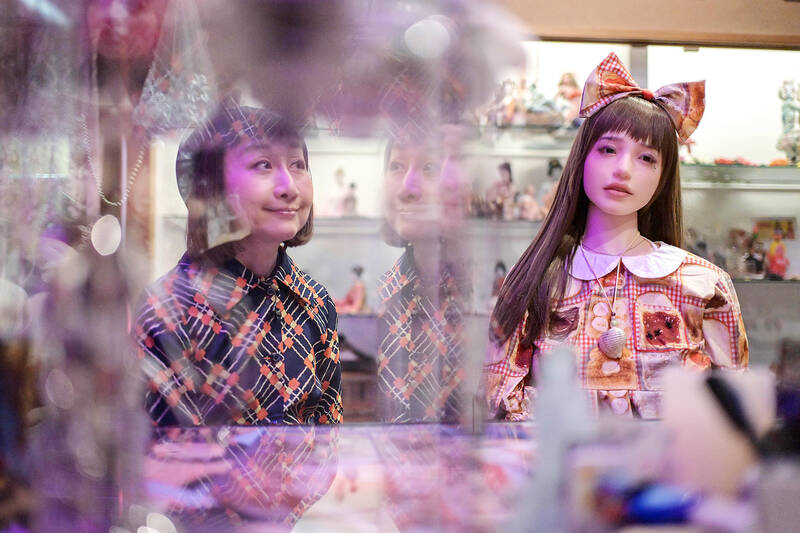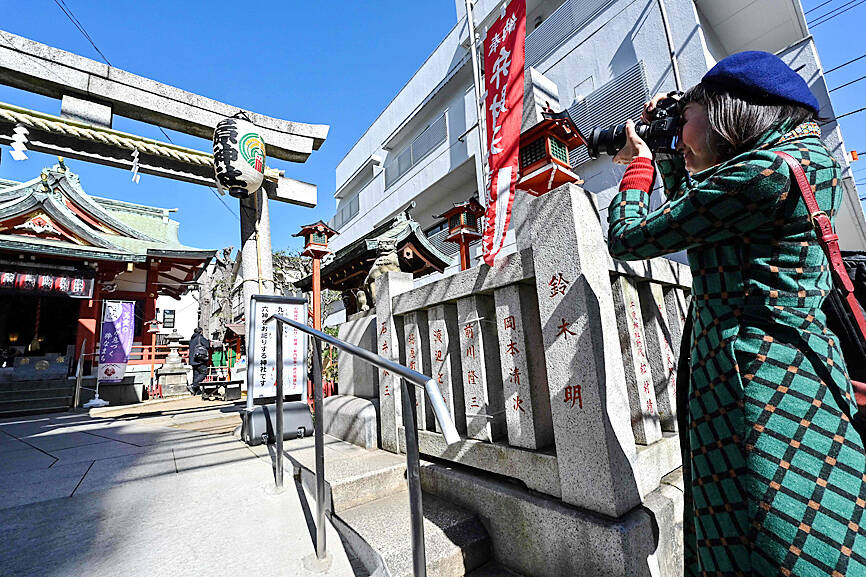It was late morning and steam was rising from water tanks atop the colorful, but opaque-windowed, “soapland” sex parlors in a historic Tokyo red-light district.
Walking through the narrow streets, camera in hand, was Beniko — a former sex worker who is trying to capture the spirit of the area once known as Yoshiwara through photography.
“People often talk about this neighborhood having a ‘bad history,’” said Beniko, who goes by her nickname. “But the truth is that through the years people have lived here, made a life here, sometimes struggled to survive. I want to share that reality.”

Photo: AFP
In its mid-17th to 19th century heyday, Yoshiwara was home to high-class courtesans who sold a world of luxurious closed-door entertainment and fantasy.
The sole entrance to the lively walled pleasure quarters was a huge golden gateway topped with a figurine of Benten, the goddess of music, art, wealth and femininity.
Today the same point is marked by two plain pillars, and the brothels of the area in eastern Tokyo are often run under the guise of bathhouses.

Photo: AFP
Beniko, 52, spent a decade working in one of the so-called soaplands after a difficult childhood during which she was bullied at school.
While studying art in the capital, she began working part-time at a small city-center establishment selling sexual services, then at age 22, she moved to Senzoku Yon-chome, the modern name for the old Yoshiwara area.
A former client had “made Yoshiwara out to be hell on earth. He said: ‘If you go there, your life will be over,’” she said. “But I felt like I belonged nowhere, so I decided to take myself there.”
To regulate the sex industry, the Yoshiwara red-light district was originally built in a different part of Tokyo in 1618, with entry tightly controlled to stop the women from escaping.
However, after being razed in a fire 40 years later, it was moved to east Tokyo, close to current-day tourist hot spot Asakusa.
Yoshiwara prospered in that location until the end of Japan’s Edo period in 1868, but it went into decline as the country modernized and when sex work was outlawed in 1958.
Beniko’s photographs, taken in Tokyo, but also in other Japanese red-light districts, focus mainly on the buildings and rooms used that are usually hidden from view.
After the success of her first photography book, Beniko financed another through online donations.
She crowd-funded ¥8.2 million (US$55,165), beating her ¥1 million goal many times over.
“I can’t make up for lost time, but I want to document the sex industry as part of history,” said Beniko, who also runs guided tours of the area.
It is a purpose shared by Go Watanabe, who runs the Senzoku Yon-chome bookshop Kastori, which specializes in the stories of former and active red-light districts in Japan.
“Of course, there are many complicated issues here, but does that mean we should simply hide or erase a town with such a complex history? Personally, I don’t think so,” he said.
By her early 30s, Beniko felt she had no future and was suffering intense physical pain.
“Some days I would see 10 clients,” she said. “I was a shell, both physically and mentally.”
She decided to focus on raising her son and found a regular part-time job, then began to teach herself photography techniques, throwing herself into the art form.
Speaking openly about sex is still somewhat taboo in Japan, but Beniko has always shown her face, including on her YouTube channel — making her the target of vicious online attacks.
“I’ve received many comments like: ‘A child brought up by a woman like you, a former prostitute, will never turn out OK,’” she said.
However, “if I didn’t show my face and speak about it openly, it wouldn’t have the same impact — or people wouldn’t truly understand,” she added.
Unlike the bright, brash Kabukicho red-light district in the central Shinjuku area of Tokyo, until recently tourists were a rare sight in Senzoku Yon-chome.
In the past few years, outside interest in the area’s history has been growing, helped by its portrayal in pop culture such as the global hit anime movie Demon Slayer.
Yoshiwara has also featured as a backdrop in a period drama shown this year on public broadcaster NHK, piquing the interest of some Japanese people curious about lesser-known historic areas of their capital.
As Japanese society changes and “external constraints” over customs and lifestyles dissipate, “some people feel a sense of unease,” Watanabe said. “That’s why many of them are looking into history, as a way to understand their own sexuality and identity.”

SELL-OFF: Investors expect tariff-driven volatility as the local boarse reopens today, while analysts say government support and solid fundamentals would steady sentiment Local investors are bracing for a sharp market downturn today as the nation’s financial markets resume trading following a two-day closure for national holidays before the weekend, with sentiment rattled by US President Donald Trump’s sweeping tariff announcement. Trump’s unveiling of new “reciprocal tariffs” on Wednesday triggered a sell-off in global markets, with the FTSE Taiwan Index Futures — a benchmark for Taiwanese equities traded in Singapore — tumbling 9.2 percent over the past two sessions. Meanwhile, the American depositary receipts (ADRs) of Taiwan Semiconductor Manufacturing Co (TSMC, 台積電), the most heavily weighted stock on the TAIEX, plunged 13.8 percent in

A wave of stop-loss selling and panic selling hit Taiwan's stock market at its opening today, with the weighted index plunging 2,086 points — a drop of more than 9.7 percent — marking the largest intraday point and percentage loss on record. The index bottomed out at 19,212.02, while futures were locked limit-down, with more than 1,000 stocks hitting their daily drop limit. Three heavyweight stocks — Taiwan Semiconductor Manufacturing Co (TSMC, 台積電), Hon Hai Precision Industry Co (Foxconn, 鴻海精密) and MediaTek (聯發科) — hit their limit-down prices as soon as the market opened, falling to NT$848 (US$25.54), NT$138.5 and NT$1,295 respectively. TSMC's

TARIFFS: The global ‘panic atmosphere remains strong,’ and foreign investors have continued to sell their holdings since the start of the year, the Ministry of Finance said The government yesterday authorized the activation of its NT$500 billion (US$15.15 billion) National Stabilization Fund (NSF) to prop up the local stock market after two days of sharp falls in reaction to US President Donald Trump’s new import tariffs. The Ministry of Finance said in a statement after the market close that the steering committee of the fund had been given the go-ahead to intervene in the market to bolster Taiwanese shares in a time of crisis. The fund has been authorized to use its assets “to carry out market stabilization tasks as appropriate to maintain the stability of Taiwan’s

STEEP DECLINE: Yesterday’s drop was the third-steepest in its history, the steepest being Monday’s drop in the wake of the tariff announcement on Wednesday last week Taiwanese stocks continued their heavy sell-off yesterday, as concerns over US tariffs and unwinding of leveraged bets weighed on the market. The benchmark TAIEX plunged 1,068.19 points, or 5.79 percent, to 17,391.76, notching the biggest drop among Asian peers as it hit a 15-month low. The decline came even after the government on late Tuesday authorized the NT$500 billion (US$15.2 billion) National Stabilization Fund (國安基金) to step in to buoy the market amid investors’ worries over tariffs imposed by US President Donald Trump. Yesterday’s decline was the third-steepest in its history, trailing only the declines of 2,065.87 points on Monday and